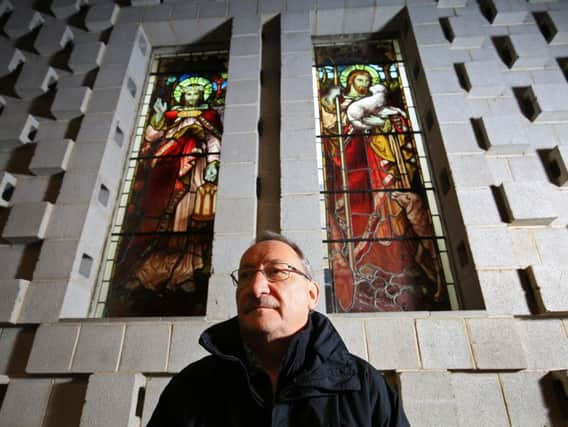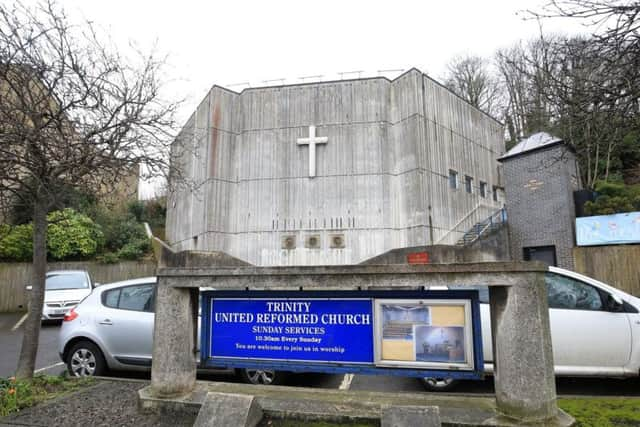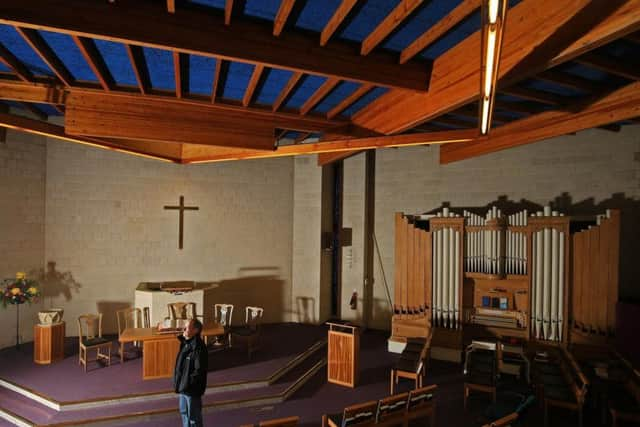Sheffield church tours put people and buildings in context


The site was a difficult one, sandwiched between busy Ecclesall Road and an immovable feature - the cliffs of Endcliffe that give the suburb its name.
Jenkinson used the surroundings as inspiration, coming up with the Trinity United Reformed Church, a place described in members' own literature as 'uncompromisingly contemporary'.


Advertisement
Hide AdAdvertisement
Hide AdIts grey concrete exterior makes it an unusual example of a church in the Brutalist style of architecture - there are few windows and, for some time, there was no cross outside and only a notice board gave away the fact the building was a place of worship.
"Somebody said to me recently 'It looks like a very expensive public convenience, clean and clinical'," says congregation member Professor Clyde Binfield, who taught history at Sheffield University.
"I personally quite like the drama of it. This was listed as one of the six ugliest buildings in Sheffield. But I'm prepared to take it."
On Saturday, February 24, those unfamiliar with the building opposite Endcliffe Park will have a chance to see inside and find out more about its story. The Yorkshire Historic Churches Trust is holding an open day, the last in a series that has visited St Mark's at Broomhill, All Saints Ecclesall, St Francis' in Crosspool and Sheffield's two cathedrals, among others.


Advertisement
Hide AdAdvertisement
Hide AdClyde has a slide in his collection that shows the church as it was in 1971, its fresh concrete gleaming in the sunshine. "It really does look white. It looks attractive."
Trinity URC was created in front of the old Endcliffe Park Congregational Church, which dates from 1901. The older venue's hall, once used as a Sunday school, still remains with original features, including the organ, benches and parquet flooring. In the 1930s the hall was extended and then in 1969 a union was made with two other churches - Cemetery Road, since demolished, and Broompark, now part of Sheffield High School. Jenkinson, a church member, was commissioned to provide extra space.
Fragments of Cemetery Road were brought in - three gothic roundels carved from stone face Ecclesall Road and, inside, two traditional stained glass windows are set within the breezeblock walls, offering an unusual contrast.
Plans had to be scaled down to keep Trinity's construction costs to £45,000. Ambitions for a two-bedroom caretaker's flat, kitchens and halls at street level were dropped to stick within the budget, Clyde says.


Advertisement
Hide AdAdvertisement
Hide Ad"Jenkinson's aim was to reflect the cliff face of faith, if you like. There's a quarry - the cliff of the quarry - behind it. His partner Derek Evans favoured red brick, which might be covered in creepers - almost a sort of 'Hanging gardens of Babylon'."
The newer part of the church - the main worship room - is to the left of the lobby. The surroundings are more comfortable than the greyness outside might suggest, furnished with exposed wooden beams, a bronze cross designed by cutler David Mellor above the pulpit and an organ originally made for the Ecclesall home of industrialist Sir William Ellis. "It's quite extraordinary to think a private house would have a chamber organ," murmurs Clyde.
Seating is tiered, and the room's small gallery or balcony can again be explained by geology, as it marks the spot where the rock ends at Endcliffe. Excavation would have been too expensive.
The open day will raise funds for the churches trust, which makes grants to venues of all denominations for repairs and restoration projects. The most recent trip in South Yorkshire was to St John's at Ranmoor, shortly after the building had to close for repairs when part of the ceiling collapsed.


Advertisement
Hide AdAdvertisement
Hide Ad"We were able to send them £480 - not a vast amount, but that's how much was raised. It's a lovely building, very important," says Clive, turning to look at Trinity. "This is totally different."
Brutalism - pioneered by architect Le Corbusier, who used the term 'béton brut', meaning 'raw concrete' - is finding favour in the 21st century. The National Trust has run tours of Park Hill flats and Clyde is a fan of the Moore Street electricity substation in Sheffield. "There's an interest about this."
The trouble with Trinity, he thinks, is that it 'hasn't weathered well'. "It looks grim from the outside, with the best will in the world. Buildings like this need tender loving care as much as the most delicate ones."
The open day runs from 10am to 4.30pm. Clyde will be speaking along with Chris Ellis, who is preparing a biography of hymn writer Isaac Watts, and church conservation expert Andrew Shepherd.
"It's about buildings, and people, and setting them in the context of the architecture of the time and the places in which they're to be found."
Visit www.yhct.org.uk/events for details.